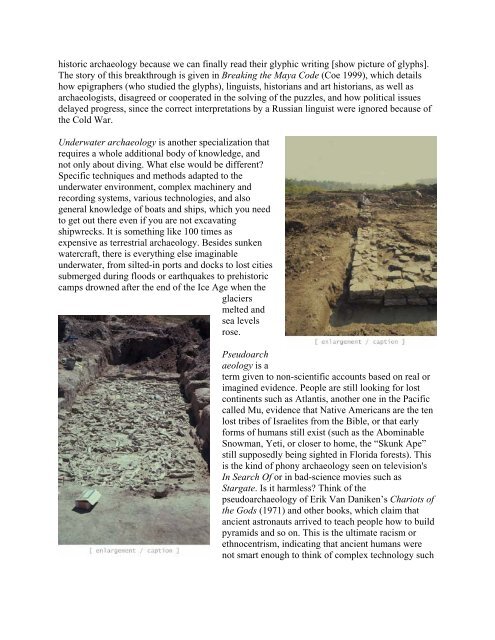INTRODUCTION TO ARCHAEOLOGY Nancy White - Touro Institute
INTRODUCTION TO ARCHAEOLOGY Nancy White - Touro Institute
INTRODUCTION TO ARCHAEOLOGY Nancy White - Touro Institute
You also want an ePaper? Increase the reach of your titles
YUMPU automatically turns print PDFs into web optimized ePapers that Google loves.
historic archaeology because we can finally read their glyphic writing [show picture of glyphs].<br />
The story of this breakthrough is given in Breaking the Maya Code (Coe 1999), which details<br />
how epigraphers (who studied the glyphs), linguists, historians and art historians, as well as<br />
archaeologists, disagreed or cooperated in the solving of the puzzles, and how political issues<br />
delayed progress, since the correct interpretations by a Russian linguist were ignored because of<br />
the Cold War.<br />
Underwater archaeology is another specialization that<br />
requires a whole additional body of knowledge, and<br />
not only about diving. What else would be different?<br />
Specific techniques and methods adapted to the<br />
underwater environment, complex machinery and<br />
recording systems, various technologies, and also<br />
general knowledge of boats and ships, which you need<br />
to get out there even if you are not excavating<br />
shipwrecks. It is something like 100 times as<br />
expensive as terrestrial archaeology. Besides sunken<br />
watercraft, there is everything else imaginable<br />
underwater, from silted-in ports and docks to lost cities<br />
submerged during floods or earthquakes to prehistoric<br />
camps drowned after the end of the Ice Age when the<br />
glaciers<br />
melted and<br />
sea levels<br />
rose.<br />
Pseudoarch<br />
aeology is a<br />
term given to non-scientific accounts based on real or<br />
imagined evidence. People are still looking for lost<br />
continents such as Atlantis, another one in the Pacific<br />
called Mu, evidence that Native Americans are the ten<br />
lost tribes of Israelites from the Bible, or that early<br />
forms of humans still exist (such as the Abominable<br />
Snowman, Yeti, or closer to home, the “Skunk Ape”<br />
still supposedly being sighted in Florida forests). This<br />
is the kind of phony archaeology seen on television's<br />
In Search Of or in bad-science movies such as<br />
Stargate. Is it harmless? Think of the<br />
pseudoarchaeology of Erik Van Daniken’s Chariots of<br />
the Gods (1971) and other books, which claim that<br />
ancient astronauts arrived to teach people how to build<br />
pyramids and so on. This is the ultimate racism or<br />
ethnocentrism, indicating that ancient humans were<br />
not smart enough to think of complex technology such
















